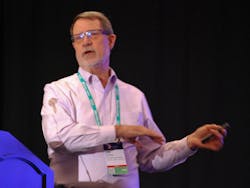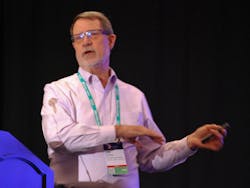Air Liquide upgrades with cookie-cutter compressor monitoring
If there’s “a whole lot of shakin’ going on,” everyone wants to know about it—whether it’s related to Jerry Lee Lewis or Air Liquide’s compressors. However, the problem is some vibrations are more or less apparent than others, and some measuring devices don’t provide enough details about them. This means users can’t answer the question, “What’s shakin’?” or even know if they should be trying to find out.
To overcome these limitations, Air Liquid Large Industries is upgrading the vibration-measuring components, support software and capabilities used by the air, O2, H2, and N2 compressors in its many air-separation units (ASU) at four plants in Texas. These improvements are part of the company’s overall digital-transformation initiative, which includes revamping its distributed control systems (DCS) over the past few years.
“We’d already standardized on DeltaV and PK controllers, so we thought it might be good to use Emerson’s AMS 6500 ATG system to monitor vibrations on our compressors,” said Les Dupre, process controls and special products manager, ALLIUS Center of Technical Expertise, Air Liquide Large Industries. “6500 ATG also complies with the API 670 machinery protection system (MPS) standard, so we asked Emerson to help implement sensors, vibration racks, cabinets and condition-monitoring software and connect them to our DeltaV and PI Historian, which does predictive analytics with Aveva’s Prism artificial intelligence (AI) and machine learning (ML) software. This path was good for us because we integrated 6500 ATG into DeltaV and worked with Puffer.”
Salim Jaffer, business development manager for reliability solutions at Puffer-Sweiven, an Emerson Impact Partner, who presented, along with Dupre at Emerson Exchange, added, “Air Liquide also needed to upgrade its vibration-measuring technology because it previously used vibration switches, which don’t work as well with compressors.”
Air Liquide had been using vintage 3300 and 3500 vibration racks and transmitters from Bently Nevada, but it only produced 4-20 mA signals and could only send rudimentary trends back to the DCS. “However, we were able to keep the probe sides of the Bently transmitters, which was a significant savings,” added Jaffer.
Get a little help
“It may seem like air is the raw material in air separation, but it’s really the energy needed to compress air to the pressure needed for our processes,” explained Dupre. “We use centrifugal, multi-stage compressors with high-speed pinions, and we need to be aware of and measure vibrations of the bearings, seals and other areas to monitor, maintain and optimize performance. If an ASU trips, then our whole process goes down, and it’s costly to start up again. There are many advantages to good vibration monitoring.”
Dupre stated that extending its partnership with Emerson from process control into vibration monitoring provided several key benefits. These included:
- unified product support from one supplier
- commissioning synergies
- cost savings by combining vibration racks with DeltaV in the same cabinets
- one source for standardizing on vibration packages for all O2, H2, and N2 compressors
- improved availability and reliability of the compressors.
“The biggest gain to this approach was the visibility of these production machines at a corporate enterprise monitoring center and deployment of prescriptive analytics on all machines,” said Dupre. “The aim is to take this to a global level from our Houston and local, U.S.-based plants. We’re expecting to use Plantweb Optics software provide more machine visibility at the enterprise level.”
Standardize and save
As it sought a common upgrade strategy for the ASUs’ compressors, Dupre reported that AirLiquide, Puffer and Emerson developed a standardized solution. “It became like a cookie-cutter, which is what Air Liquide wanted to achieve,” said Dupre.
The company’s standard package for compressor vibration monitoring on its ASUs included AMS 6500 ATG racks; cabinets from Puffer; eddy current probes with EZ-1000 accelerometers from Emerson; and a network license for AMS Machine Works software, with a provision for increased capacity as more plants join the network.
So far, this vibration monitoring package with some variations has been installed on compressors at four Air Liquide facilities.
Three O2 vertical reciprocating compressors are installed at its plant in Channelview, Texas. They have a two-throw configuration, use AMS 6500 ATGs and include three racks with seven channels per rack.
Two horizontal reciprocating compressors are in a hydrogen-carbon monoxide (HyCo) process at its plant in Freeport, Texas. One compressor has a six-throw configuration and the other has a four-throw configuration. They’re using two ATG racks.
Centrifugal N2 compressors are at its plant in Longview, Texas. This application uses one ATG rack and employs 10 channels per compressor.
Seven N400A O2 compressors are at its plant in Nederland, Texas. This is the largest upgrade project, which has 68 probes and six ATG racks, and it uses AMS Machine Works software, as well as Machine Studio software to configure the racks. It also employs Red Lion’s HMI displays, as well as Aveva’s PI Historian and Prism software.
“These are big projects, but our goal with all of them is to give our subject matter experts (SMEs) rotating equipment data from many facilities, so they can optimize them,” said Dupre. “Communications consist of OPC UA from fiber-optic to Ethernet switches that are linked to DeltaV and our plant networks, though this is all still at Level 1 of the Purdue OSI model. They bring in vibration and other data, such as showing latches. We can also see alarm limits and put in bypasses now without having to go out to the racks. We’re also getting better data to DeltaV from our devices, which we can see on our remote faceplates without physical visits. Eventually, we’ll be able to move this data up from Level 1 to other applications by using Plantweb Optics software.”
Just on the Nederland upgrade project, Dupre reported that Air Liquide estimates it saved $150,000 to $200,000 by unifying its vibration modernization and extending from DeltaV to other Emerson solutions. These savings included engineering expenses, design and documentation costs, training for global personnel, more efficient maintenance by more easily swapping uniform parts and reduced costs for spare components by using Universal Measurement cards that incorporate all major vibration measurements, instead of using one card for each function.
“We also achieved about 8.9% total and value-added savings by integrating our individual AMS 6500 ATG and DeltaV panels into one cabinet with help from Puffer,” concludes Dupre. “In fact, we’re already planning to upgrade another seven racks at our plant in Baytown, Texas, in the second quarter of next year.”
Get the best of Emerson Exchange Americas 2022
When the event comes to a close, the best, most important coverage will be compiled into a report. Register now to pre-order the report and be among the first to receive it in your inbox.
About the Author

Leaders relevant to this article:


